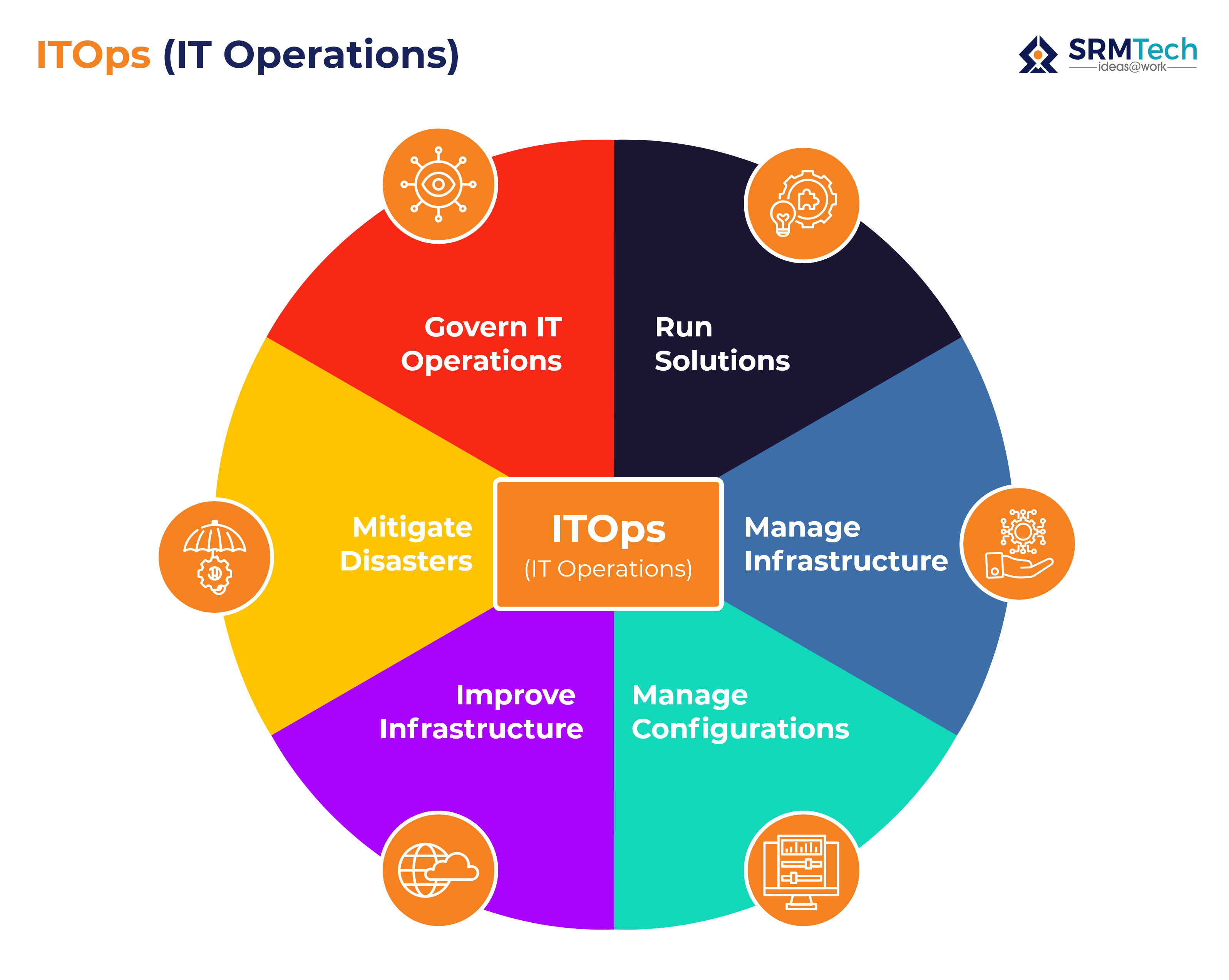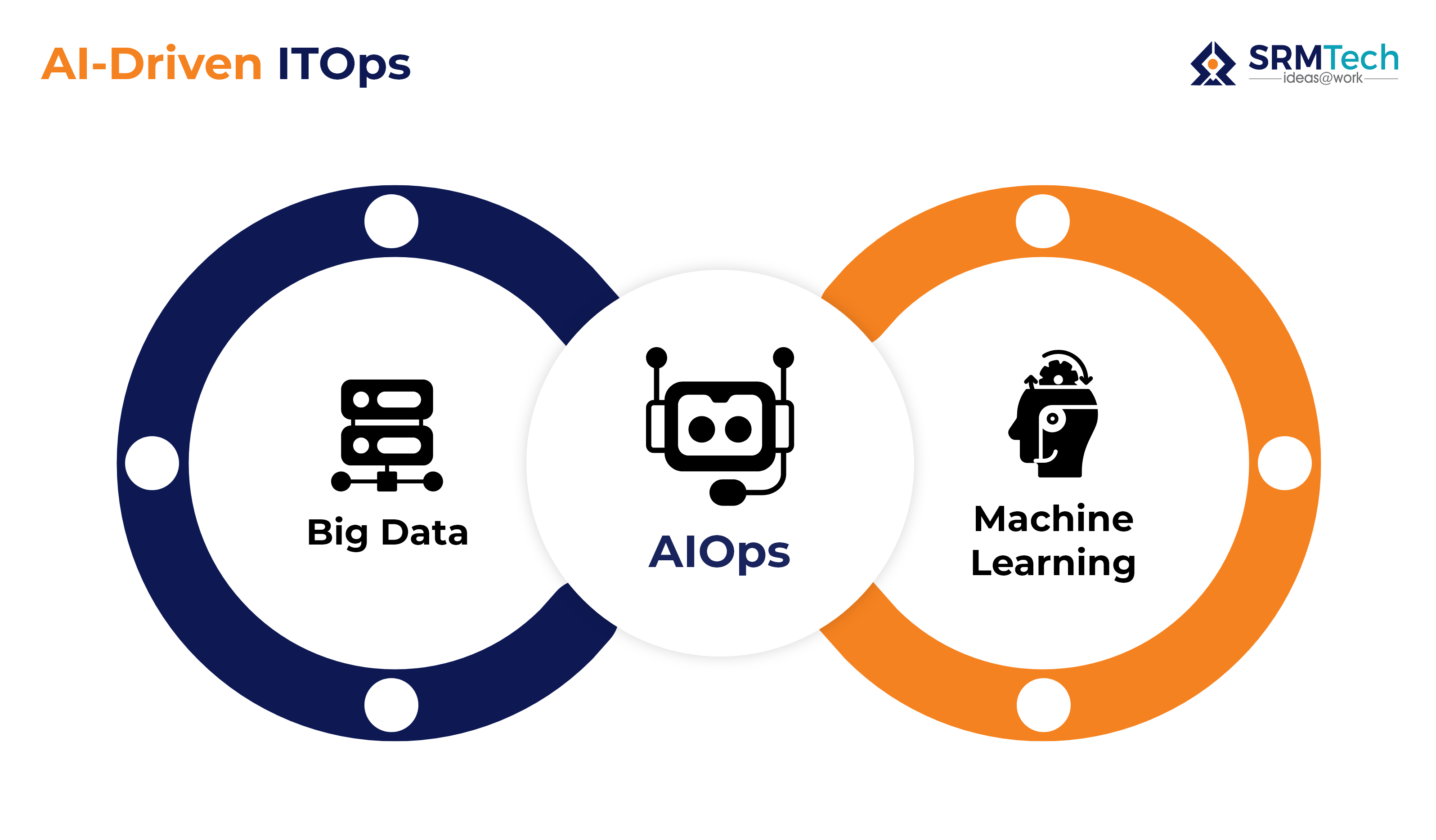As organizations increasingly embrace cloud-based technologies, the way traditional IT operations work is transforming. Conventional data centers are giving way to more complex yet sophisticated cloud ecosystems, and experts predict that by 2025, 80% of businesses will bid goodbye to their legacy data centers. There’s a notable trend among businesses towards integrating automation and virtualization into their IT operations (ITOps), aiming to optimize processes and enhance agility amidst the ever-changing business landscape. Essentially, it represents a robust solution, facilitating seamless transitions to cloud-based infrastructures, with a strong focus on IT automation and virtualization.
In this blog, let us understand what IT operations are and how they benefit modern business.
What is ITOps?
IT operations, often called ITOps, involve managing and maintaining the information technology infrastructure within a business. This critical function is typically handled by a specialized team within the IT department, assuming essential roles and responsibilities in managing the day-to-day IT needs of the organization.
55% of organizations have deployed modern IT operations technologies
to enhance customer satisfaction. [Source: PagerDuty]
So, what makes ITOps mandated in an IT environment?
ITOps involves overseeing networking operations, deploying, configuring, maintaining applications, and supervising physical and virtual elements in the IT environment, ensuring uninterrupted operations, optimizing IT system efficiency, and realizing cost-effectiveness. In addition to routine monitoring and issue resolution, the ITOps team strategically implements advanced cloud-native platforms and automation tools to streamline processes and enhance efficiency.
Considering this, the significance of ITOps in an IT environment is paramount, as it ensures the smooth functioning of business operations, contributing directly to overall operational efficiency and enhanced customer satisfaction.

Why ITOps Matters in Business Operations?
Effective IT operations (ITOps) play a crucial role in business success. If IT processes aren’t up to par, it can seriously impact service quality and overall business workflows, putting the organization’s competitiveness at risk. That’s why ITOps is rudimental for improving business processes and ensuring everything runs smoothly. Modernizing IT operations involves embracing cloud platforms, implementing advanced cybersecurity measures, and staying on top of innovative technology practices. This leads to a more agile and cost-efficient IT ecosystem for businesses, a must to remain driven and protect the company’s reputation.
A one-size-fits-all IT approach no longer cuts for today’s business thriving in digital realms. The smart move is adopting a flexible hybrid IT strategy. This means combining the reliability of on-premises solutions with the innovation potential of cloud solutions for ITOps. It’s like getting the best of both worlds, essential for keeping a competitive edge backed with high-performing IT infrastructure.
Having said that, let us quickly see the benefits of ITOps in businesses below.
Enhancing Operational Efficiency
In a well-functioning organization, the role of ITOps often goes unnoticed during smooth operations. However, when disruptions occur, the significance of IT operations becomes prominent. Business system downtime and security breaches pose considerable risks, making ITOps in 2024 essential for avoiding expensive incidents and ensuring swift resolutions.
ITOps plays a crucial role in improving efficiency within the organization and maintaining the integrity of organizational systems by averting security breaches. Consider a scenario where ITOps, through proactive security measures, fortifies the IT infrastructure against potential threats. In the face of a security breach attempt, ITOps swiftly identifies and mitigates vulnerabilities, preventing data compromise. This rapid response safeguards sensitive information and ensures uninterrupted business continuity.
Ensuring Seamless Functionality
ITOps teams in any business employ digital experience monitoring tools to evaluate critical metrics like success rate, error rate, and task completion time. This proactive approach allows them to identify and address usability issues, such as prolonged website loading times or errors during checkout, thereby significantly enhancing the overall quality of the customer experience. Simultaneously, ITOps plays a pivotal role in ensuring that IT services, like those in an e-commerce platform, function seamlessly. By continuously maintaining and enhancing service functionality, ITOps aligns these services with business requirements, effectively meeting user needs and showcasing the functional effectiveness of the system.
Elevating System Reliability
Reliability is paramount in today’s 24*7 “ON” trend, where employees must be assisted with seamless system functionality to meet customer expectations. ITOps focuses on attributing high uptime for business systems by emphasizing rapid response and issue resolution. Through tools like real-time service desks and automated communication channels, ITOps ensures efficient reporting and early warnings, enabling IT teams to address problems swiftly. By measuring key IT metrics like mean time to detect, mean time to repair, and mean time between failures, ITOps can systematically monitor and enhance the reliability of IT systems.
For instance, in a scenario where a critical server experiences an unexpected outage at 2 AM, ITOps immediately receives alerts. The team swiftly responds, identifies the root cause, and pushes automated recovery protocols, ensuring minimal downtime and maintaining uninterrupted service availability around the clock.
Enhancing System Performance
ITOps diligently optimizes critical metrics like response time, uptime, and throughput to elevate IT system performance. An exemplar is an online banking platform ensuring swift transactions, accurate information, and high availability. Simultaneously, ITOps contributes significantly to overall productivity, streamlining business processes. Leveraging tools like Jira Service Management for efficient issue resolution enhances reliability and reclaims lost hours during outages, translating into tangible efficiency benefits for the organization.
In illustrating the integration of ITOps in companies, consider how adopting AWS (Amazon Web Services) emerges as a strategic imperative for businesses navigating modernization complexities. Incorporating AWS ITOps tools like CloudWatch, X-Ray, and CloudTrail helps achieve proactive monitoring, high availability architecture, and auto-scaling, seamlessly enhancing reliability and significantly reducing downtime while optimizing performance metrics. The strategic incorporation of AWS’s disaster recovery planning managed services, and security best practices further fortify businesses against disruptions, ensuring a resilient and efficient IT environment.
Hence, investing in ITOps is vital for businesses as it guarantees IT systems’ security, reliability, and compliance with industry standards. By optimizing IT operations, organizations gain a competitive advantage, positioning themselves for sustained growth and success.
ITOps Examples
Integrating IT Operations (ITOps) tools has proven instrumental in optimizing organizational competence and enhancing overall performance. These tools, designed to streamline processes, automate tasks, and ensure seamless communication, have become indispensable in the modern business ecosystem. Here are some examples:
1.Monitoring and Alerts
- Leverage ITOps monitoring tools to constantly monitor systems for performance issues, promptly notifying teams of critical events to ensure proactive problem resolution.
2.Incident Management
- Efficiently track, resolve, and learn from IT issues using ITOps incident management tools, following established response procedures and escalation protocols for effective incident resolution.
3.Automation and Configuration Management
- Integrate ITOps tools to streamline tasks through automation, maintaining consistency in system configurations across the users and environments.
4.Deployment and Release Management
- Employ ITOps tools to automate software deployment with CI/CD pipelines, manage version control, plan releases, and implement seamless updates and rollback strategies.
5.Capacity Planning and Optimization
- Integrate ITOps Capacity Planning tools to analyze resource utilization, plan for scalability, and optimize system performance through ongoing monitoring, tuning, and proactive capacity management.
6.Network Monitoring and Optimization
- Utilize ITOps tools like SolarWinds or Cisco Prime to continuously monitor network devices, bandwidth usage, and latency.
- Analyze network performance metrics to identify bottlenecks and optimize configurations for efficient communications and data transmission.
- Implement QoS (Quality of Service) policies through ITOps tools to prioritize critical traffic and ensure optimal network performance for all users.
By seamlessly integrating these ITOps examples with dedicated tools, organizations can enhance their operational efficiency, reduce downtime, and proactively address challenges in their IT infrastructure.
Strategies for Successful Integration of ITOps
Adopting Technological Advancements:
Achieving a competitive edge through successful ITOps integration prerequisites businesses’ deep understanding of modern IT platforms and innovations that include but are not limited to cloud computing, data center innovations, security solutions, and automation tools. Organizations should foresee ITOps trends and proactively try to assess and integrate these new tools and technologies into their infrastructure. This approach helps the organization to remain agile and seek relevancy amidst modern business transformations.
Aligning with Business Priorities:
A cornerstone strategy must involve responding to organizational needs through a business-centric framework. IT operations professionals are pivotal for this alignment, requiring a unique blend of technical expertise and a deep understanding of business objectives. This dual proficiency ensures that the implementation of ITOps strategies resonates with overarching strategic goals, establishing a symbiotic relationship between technology initiatives and broader business imperatives.
Harnessing IT Automation:
A vigilant exploration of IT automation opportunities, especially in data management, forms a critical strategy. Investing in IT automation yields substantial rewards, expediting real-time data processing while mitigating the risk of human errors. Leveraging automated monitoring tools enhances visibility, leading to faster issue resolution and optimized system performance. This strategy establishes a foundation for efficiency and reliability in ITOps processes, fostering a streamlined and proactive operational environment.
Defining Key Performance Metrics:
Thoughtfully establishing and routinely evaluating key performance indicators (KPIs) are integral to monitoring ITOps teams’ progress in agile IT environments. These metrics should align closely with organizational priorities, enabling consistent evaluation of productivity and efficiency. Regular tracking and adjustment of these metrics ensure sustained optimal performance, fostering a culture of continuous improvement within the ITOps framework. This iterative approach to performance measurement contributes to the organization’s ability to adapt and thrive in dynamic business settings.
ITOps vs. DevOps and DevSecOps vs CloudOps
| Aspect | ITOps | DevOps | DevSecOps | CloudOps |
| Responsibility | Encompasses all IT operations, addressing the diverse needs of end users and business objectives. | Incorporates Agile CI/CD practices and continuous improvement of development workflows. | Involves seamless application security integration into development workflows, ensuring robust security measures throughout the development lifecycle. | Emphasizes managing complexity in cloud-based operations, ensuring efficiency and reliability in the cloud environment. |
| Focus | Broad visibility of the IT infrastructure and system applications. | Continuous integration and delivery (CI/CD) practices. | Enhanced security integrated into development and operations. | Streamlining & optimizing cloud-based operations for efficient, reliable, and secure performance. |
| Collaboration | Works independently on IT operations. | Works in conjunction with IT and some overlap with ITOps. | Collaboration between Security and DevOps domain, embedding security throughout. | Collaboration between IT and DevOps to manage cloud environments. |
AI-Driven ITOps: Shaping the Future of IT Operations
AIOps, or Artificial Intelligence for IT Operations and Maintenance, is poised to revolutionize the field of ITOps by leveraging AI and machine learning capabilities to enhance the IT operations management and analysis of IT systems and data. It combines big data analytics, automation, and machine learning to improve incident detection, reduce downtime, and optimize IT operations.
With AIOps, organizations can process and analyze vast amounts of data from various sources, including logs, metrics, events, and monitoring tools. Machine learning algorithms can proactively identify patterns, anomalies, and correlations to detect and resolve issues more efficiently. This enables ITOps teams to conduct proactive incident management, minimizing the impact of system disruptions and outages.
By automating routine tasks and providing real-time insights, AIOps enables IT operations teams to streamline operations, improve efficiency, and focus on strategic initiatives. It helps predict and prevent future IT incidents, optimize resource allocation, and detect security threats.

Implementing AIOps can benefit businesses significantly, including improved system performance, increased uptime, reduced mean time to repair, and enhanced end-user experience. It empowers organizations to make data-driven decisions, improve operational agility, and deliver better IT services.
As businesses embrace digitalization, ITOps in 2024, without any doubt, will undergo a transformative shift, urging companies to harness noble technology practices for tangible business returns. With a heightened focus on data-driven decision-making, organizations will also leverage analytics and machine learning for profound operational insights into their IT ecosystem.
Implementing IT operations is no longer a mere choice but an essential strategy, propelling businesses toward sustained success and delivering unparalleled services for any business to thrive in this competitive world.
SRM Tech has proven expertise in redefining business operations to become more value-centric for enterprises across various domains with modern ITOps practices. Connect with our Digital Infrastructure teams and explore how we can assist you in strategizing, designing, and leveraging optimal IT infrastructure solutions that uncover opportunities to sustain reliable and high-performing systems for your business endeavours.






